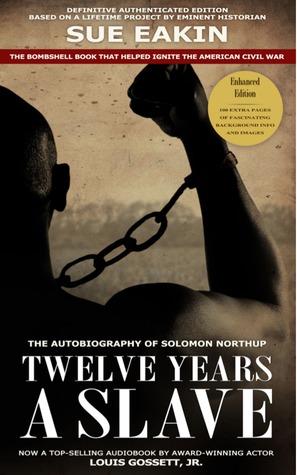Solomon Northup, Twelve
Years a Slave
1853; new edition with supplementary material and notes,
edited by Sue Eakin, Eakin Films & Publishing, 2013.

We read this simply because the
film had come out in the UK; otherwise, like so many people, we would never
have heard of it. The book itself is fascinating. For those who had read Uncle Tom’s Cabin by Harriet Beecher
Stowe, the story was horribly familiar – it confirms in a factual account what
Stowe had written as fiction.
The Eakin edition is well worth
getting, though some would recommend reading the narrative first and then the
introduction, notes, appendices etc. Northup did not write the book himself,
though it is told in the first person. As is explained by Eakin, Northup told
his story to David Wilson, who wrote it up for publication. I say “wrote it up”
and not “wrote it down” because the style and ornamentations are almost
certainly all Wilson’s, not Northup’s. Still, the narrative
does not lose the enormity of this story, the emotions and the pain undergone
by Northup and the other slaves. You are sucked right in, and feel exasperated
and agonized by what they experience. The book was written in a very short
space of time to ride on the back of the success of Uncle Tom’s Cabin, as well as possibly to identify Solomon’s two
kidnappers via those who read his story.
The book was
written for a white audience, telling them the story of a slave’s life from
kidnap or purchase from the slave-pen, to cotton-picking, sugarcane-cutting,
labouring and trying to avoid minute by minute, every day and night, the
cruelty of a master who could whip them for no reason and at any time.
We spent a lot of time discussing
how people could treat slaves as they did. (Not all slave-owners were cruel,
but very many of them were.) In the dialogues between Epps (Northup’s owner)
and Bass (the abolitionist who eventually rescued him), it is made clear that
slave-dealers and slave-owners convinced themselves, helped by the social
acceptance of the practice, that slaves, “people of color” (and another word
which is no longer printable), were simply not human beings. Many people in Louisiana and the rest of America
believed slaves were an inferior species, little higher than an animal, with
speech and limited intellect, and no rights. This is exactly what the
Nazis and other twentieth-century abusers thought about their prisoners; and it
is what pro-abortionists think about unborn babies. It is
the only way that any of them can justify what they do. Slavery was legal then,
as abortion is legal now; and as Bass tells Epps (chapter 19), the law said
Epps had the right to hold slaves, “but, begging the law’s pardon, it lies.”
Epps and Tibeats, as well as the
brief comment about Epps’s son (chapter 18), show the effects of the slave
system on the people in it. The fact of being given unlimited power over
others, and being allowed to inflict suffering on others without ever being
called to account or punished for it, inevitably brings out the worst extremes
of brutality in some (not all) people. The story of Epps’s dancing sessions (chapter
13) is hideously reminiscent of the behaviour of some of the Nazis in occupied
Poland, the ghettoes and the concentration camps.
Some notes from chapters:
Chapter 6
The
separation of Eliza from her children is heart-wrenching and difficult to read
whether the reader is a mother or daughter. However, it is uncertain whether all
of the “free” audience, who were the book’s target, could appreciate that a
mother’s love and family ties were experienced by “slaves” in the same way.
Chapter 8
Northup/Wilson
gives a history of plantations: land was cheap, and owners were rich. There was
a huge drive to cultivate the land. Slaves were mortgaged and therefore worth a
lot when alive, so that however much the planter or overseer wanted to whip
them it was against their interests to kill them. Ford believed they were an
investment worth looking after, and not to be ill-treated. He devised a Code of
Conduct of Slaves, also known as the Plantation survival code: without slaves,
crops could not be raised, no income generated to pay off the money borrowed by
the planter. This was a society of debt and credit (as Bass says in Chapter 19)
Chapter 12
A description
of slave life: planting cotton and tilling over 4 weeks, with the lead tiller
whipping them if they lagged behind him. One of the most accurate accounts of
the process ever recorded for that time. It also revealed how long
they worked – in the field from the crack of dawn until dark, then the cotton
had to be weighed (a separate chapter on being beaten if you did not collect a
sufficient load) and dried. Then the slaves had to go and make their
dinner for that night and lunch for the following day, before they were able to
sleep.
Chapter 15
The benefit
of Solomon’s ability to play the violin – it gave him money to buy shoes, and
also to witness how other rich plantation masters lived. Christmas time was the
only time when slaves were free and did not have to work – for 3, 4, or even 5
days, depending on their master’s decision.
The
education Solomon Northup had received from Sabbath School as a boy was at the
insistence of his father, himself a freed slave.
Chapter 19
The
discussion of slavery between Epps and Bass was another eye-opener for the
readers on the attitudes of that time. This is a brilliant chapter which could form
the basis for school discussion on the topic today.
